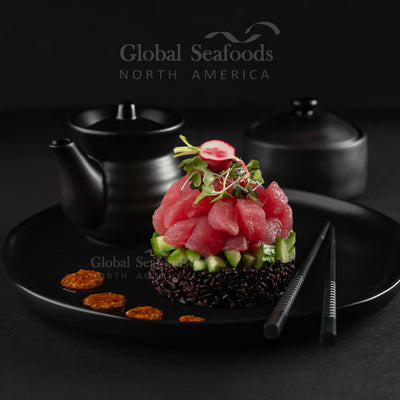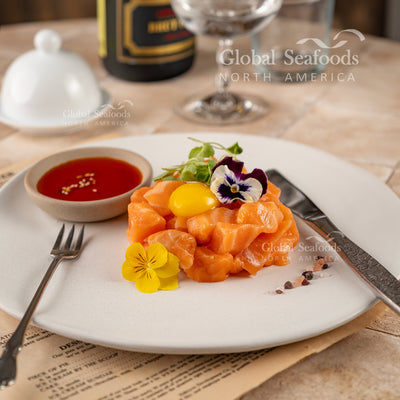Trending Poke Tuna: Why This Seafood Sensation Is So Popular

Poke Tuna: the Hottest Seafood on the Market
Poke tuna has become a global culinary sensation, captivating food lovers with its fresh flavors, vibrant presentation, and versatility. Originating in Hawaii, poke has evolved from a local delicacy into one of the most sought-after seafood dishes worldwide. Its mix of high-quality raw tuna, bold seasonings, and customizable toppings makes it a perfect choice for health-conscious diners and foodies alike.
This article explores why poke tuna is trending, its cultural significance, and tips for making this seafood favorite at home.
What Is Poke Tuna and Why Is It Trending?
The Basics of Poke Tuna
Poke (pronounced poh-kay) translates to “slice” or “cut into pieces” in Hawaiian. It typically features cubed raw tuna marinated in soy sauce, sesame oil, and other flavorful ingredients. Poke bowls are often served with rice or greens and topped with vegetables, fruits, and crunchy garnishes.
Why It’s Trending
- Health Appeal: Packed with protein, omega-3s, and low in calories, poke tuna fits into many dietary preferences.
- Customization: Poke bowls allow endless personalization, catering to individual tastes.
- Global Fusion: Combining traditional Hawaiian flavors with international influences, poke appeals to diverse palates.
Chef Roy Choi, a pioneer of fusion cuisine, describes poke as “an intersection of tradition and innovation—a dish that tells a story while evolving with the times.”
The Cultural Origins of Poke Tuna
Poke traces its roots to Hawaii, where native Polynesians seasoned raw fish with sea salt and seaweed. Over time, Japanese immigrants introduced soy sauce, sesame oil, and other flavors, giving poke its modern twist. Today, poke symbolizes Hawaii’s multicultural heritage and its love for fresh, local ingredients.
Poke Tuna’s Rise to Global Popularity
1. The Sushi Boom Effect
The global rise of sushi paved the way for poke’s popularity. Like sushi, poke features raw fish, but its casual presentation and customizable format make it more accessible.
2. Health-Conscious Dining Trends
As more people adopt health-focused diets, poke has emerged as a nutrient-rich option that doesn’t compromise on flavor.
3. Instagram-Worthy Appeal
Brightly colored ingredients and artful arrangements have made poke bowls a hit on social media platforms.
How to Choose the Best Tuna for Poke
The quality of tuna is the cornerstone of a great poke bowl. Here’s how to pick the best:
- Sushi-Grade Label: Indicates the tuna is safe for raw consumption.
- Bright Color: Fresh tuna is vibrant red or pink.
- Firm Texture: Should feel firm and moist, not mushy.
Top Tuna Options for Poke:
Creating the Perfect Poke Bowl
Essential Ingredients
- Base: Steamed rice, quinoa, or mixed greens.
- Tuna: Sushi-grade tuna diced into cubes.
- Marinade: Soy sauce, sesame oil, rice vinegar, and optional chili flakes.
- Toppings: Avocado, cucumber, seaweed salad, pickled ginger, and sesame seeds.
Step-by-Step Instructions
- Dice the tuna into uniform cubes.
- Mix a marinade of soy sauce, sesame oil, and rice vinegar. Toss the tuna in the marinade and let it rest for 15 minutes.
- Assemble the bowl with your chosen base, marinated tuna, and toppings.
Delicious Poke Tuna Variations
1. Classic Hawaiian Poke
- Ingredients: Fresh ahi tuna, Hawaiian sea salt, ogo seaweed, sesame oil.
- Flavor Profile: Simple and authentic.
2. Spicy Tuna Poke
- Ingredients: Tuna, sriracha, mayonnaise, masago, and sesame oil.
- Flavor Profile: Creamy with a spicy kick.
3. Mango-Avocado Poke
- Ingredients: Tuna, diced mango, avocado, lime juice, and cilantro.
- Flavor Profile: Sweet, tangy, and refreshing.
4. Vegan Poke
- Ingredients: Diced watermelon or marinated tofu.
- Flavor Profile: Light and plant-based, perfect for non-seafood eaters.
The Health Benefits of Poke Tuna
Poke tuna isn’t just delicious—it’s also incredibly nutritious:
- Protein-Packed: Supports muscle repair and boosts energy.
- Rich in Omega-3s: Promotes heart and brain health.
- Low in Calories: Ideal for weight management.
- Loaded with Vitamins: Ingredients like avocado, seaweed, and cucumber add fiber, vitamins, and antioxidants.
According to the Harvard T.H. Chan School of Public Health, omega-3 fatty acids found in fish like tuna can lower the risk of chronic diseases, including heart disease and diabetes.
FAQs About Poke Tuna
1. Can I use frozen tuna for poke?
Yes, as long as it’s labeled sushi-grade and properly thawed.
2. How long does poke tuna last?
Poke is best eaten fresh but can be refrigerated for up to 24 hours.
3. Is poke tuna gluten-free?
It can be. Use gluten-free tamari instead of soy sauce for the marinade.
4. Can I make poke with cooked fish?
Yes! Cooked shrimp, seared tuna, or even tofu can replace raw tuna.
5. What’s the best way to serve poke?
Poke is traditionally served over rice, but you can use greens, noodles, or even tortilla chips for a fun twist.
Get Inspired with Global Seafoods
For premium-quality tuna and creative recipe ideas, explore the Global Seafoods YouTube Channel. Learn how to master the art of poke tuna with step-by-step guides and inspiration for your next culinary creation.
Conclusion
Poke tuna is more than just a trending dish—it’s a cultural experience, a health-conscious choice, and a canvas for culinary creativity. Whether you’re enjoying a classic Hawaiian poke bowl or experimenting with modern flavors, the freshness and versatility of tuna make it a must-try for any seafood lover.
Start your poke tuna journey with sushi-grade tuna from Global Seafoods. Elevate your dining experience and enjoy the hottest seafood trend of the year!
Also in News

How to Make Sea Bream Sushi With Dry-Aged Tuna & Crab Roll — Step-by-Step With Chef Joshua
A complete guide to making Sea Bream sushi at home, including filleting, curing, slicing, and building a Dry-Aged Tuna & Crab sushi roll. Chef Joshua shares professional tips for restaurant-quality results.

The Boiled Crab in Popular Culture: From Cajun Cuisine to Trendsetting Restaurant Phenomenon
From spicy Cajun-inspired seafood boils to hands-on dining experiences, The Boiled Crab has left a unique mark on popular culture. Discover its cultural roots and culinary influence.

Boiled Crab for Game Night: Everything You Need for a Perfect Seafood Party
Take your game night to the next level with a Boiled crab party. Learn the best recipes, cooking tips, and hosting hacks for a memorable seafood feast.




